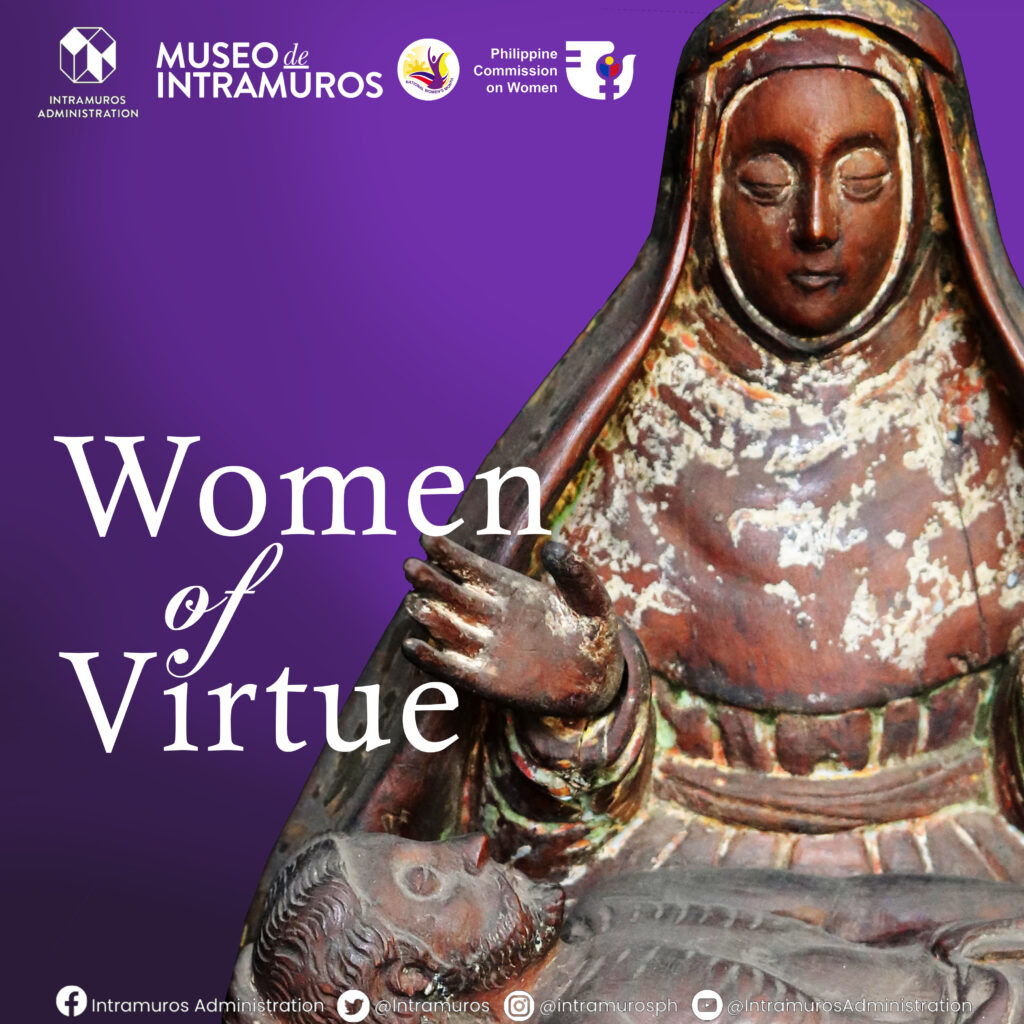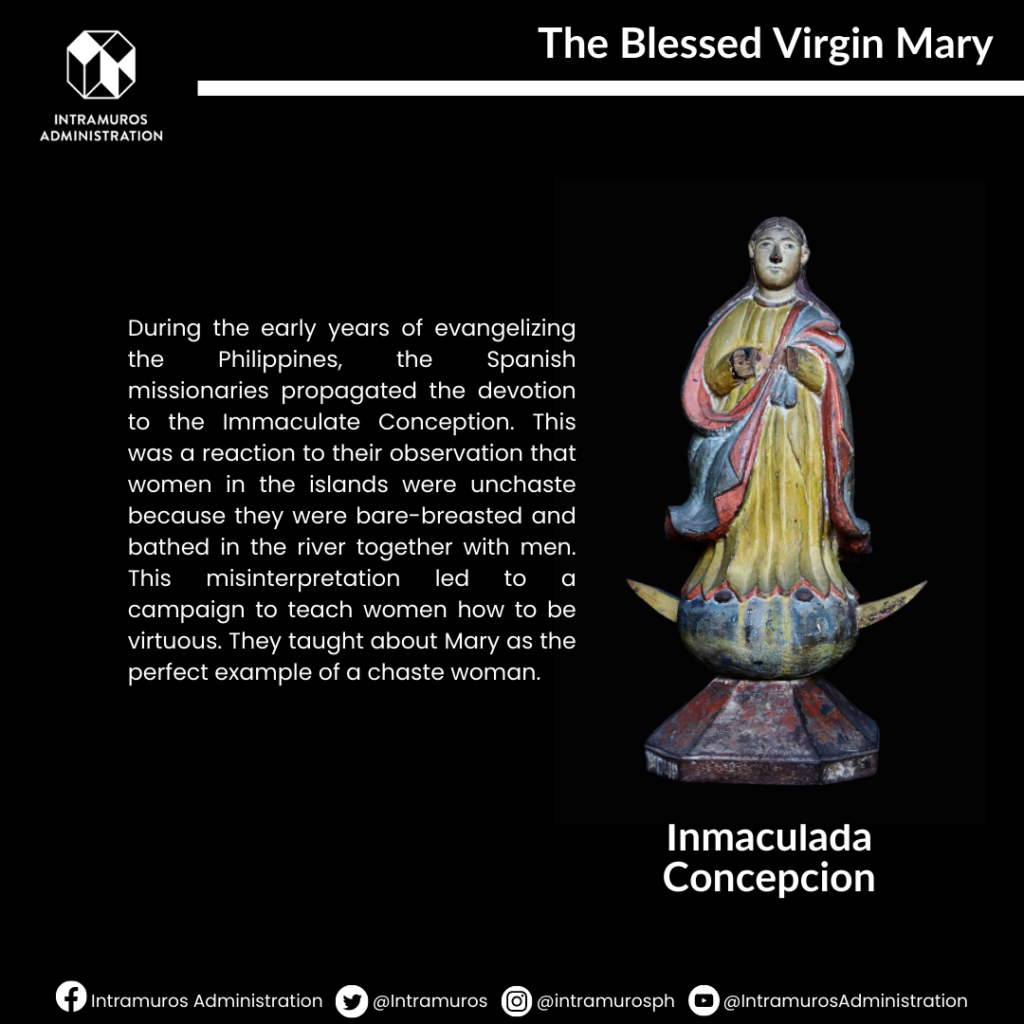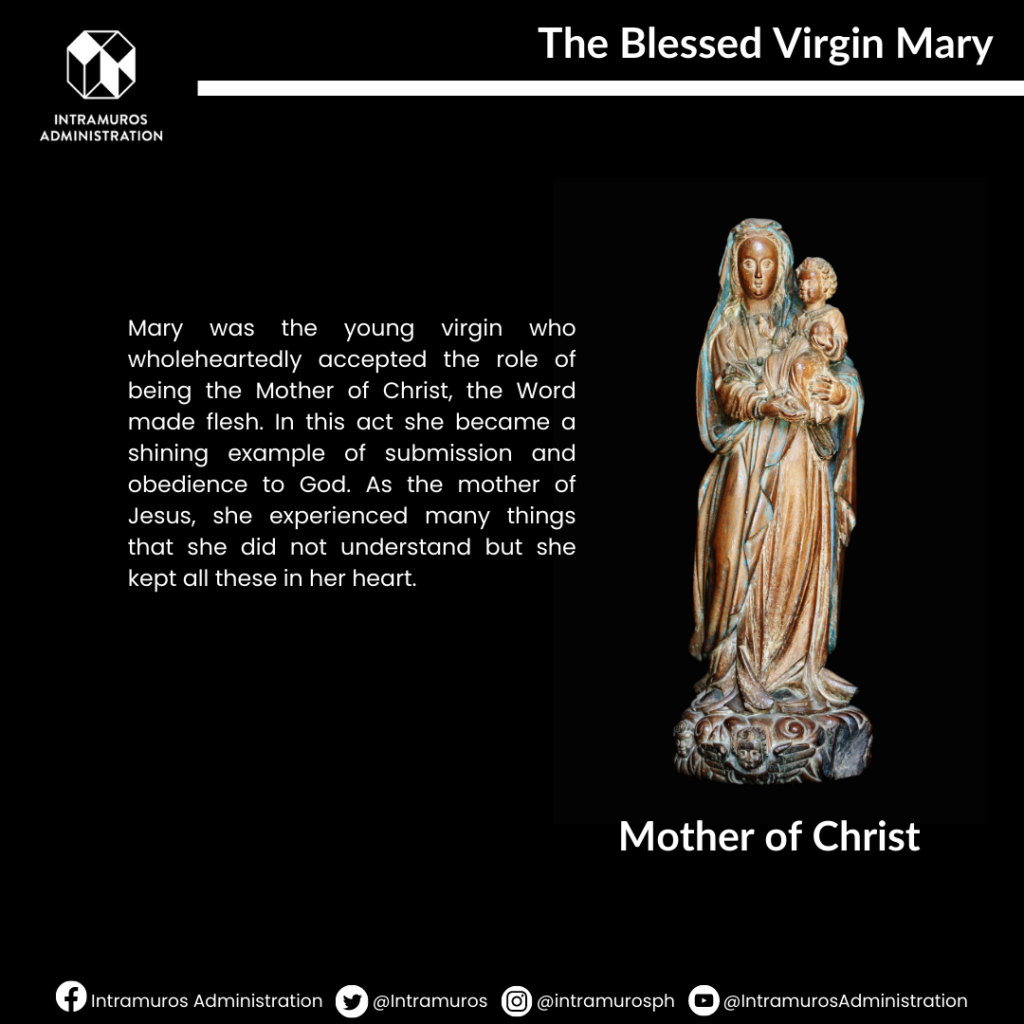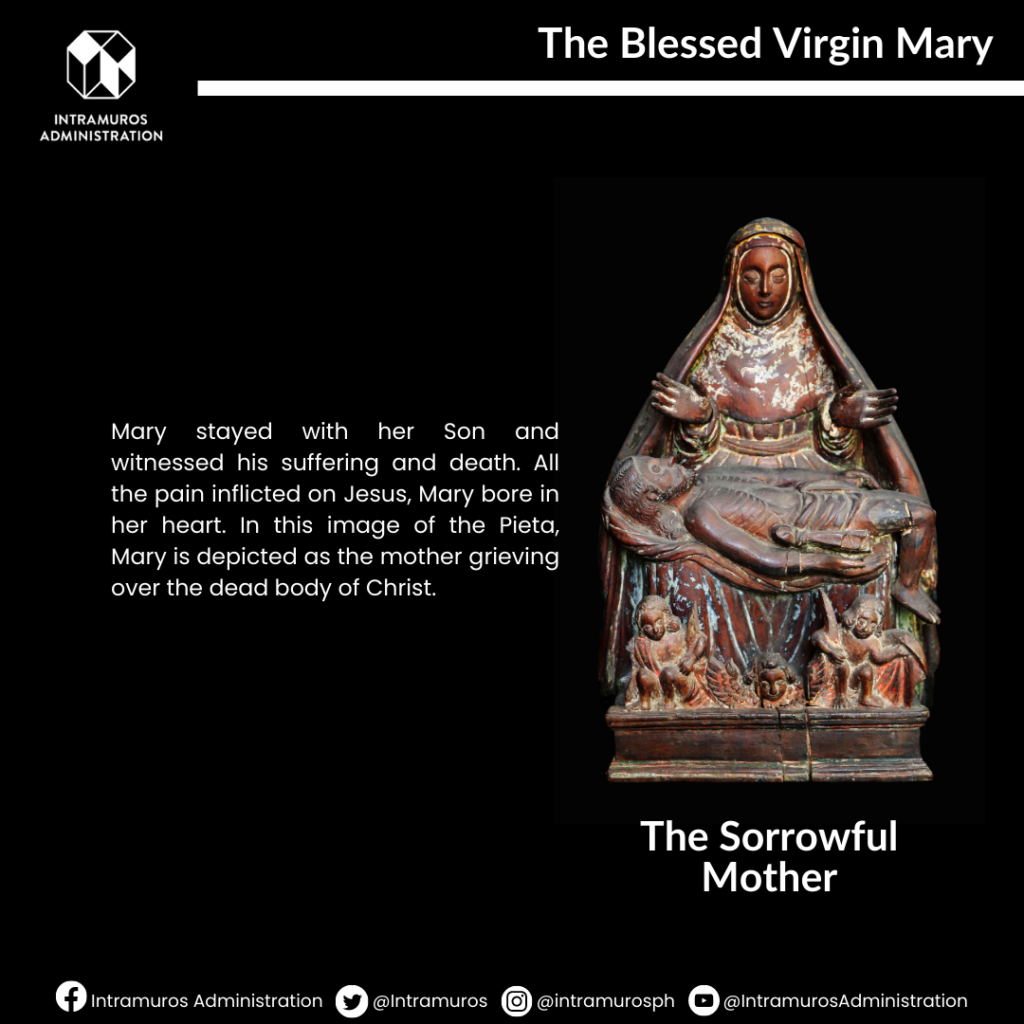
This exhibit features the venerated women in Christianity. It discusses the life and contribution of women who played important roles, gave significant contributions, and served as shining examples to women across generations. They exhibited strong conviction, courage, steadfastness, wisdom, and unwavering faith. They are symbols of both power and docility; of strength and gentleness. In time for National Women’s Month, this exhibit of pieces from the Intramuros Administration collection celebrates women of virtue from the past as it aims to inspire women of the present.
Part 1: Disciples of Christ
Sta. Maria Magdalena
- Unknown provenance and date
- Softwood
Mary of Magdala was mislabeled a penitent prostitute/adulteress, and subsequently became the beacon of hope for fallen and wayward women. Many female Biblical scholars are now restoring her reputation. She was one of the women who supported Christ’s ministry, and one of the disciples who were brave enough to stay with Jesus at the foot of the cross and accompany him to His tomb. She was also the first person to see the Risen Christ.

Sta. Maria Salome
- Unknown provenance and date
- Oil on wood
Salome was wife to Zebedee and mother to St. James the Great and John. She was one of the female disciples of Jesus who witnessed his crucifixion and went to His tomb to anoint him. This painting shows her as a “stage mother,” asking Jesus to say that her sons will sit beside Him, one on his right and one on his left when He becomes king. (Mt. 20:20-28)

Sta. Marta de Betania
- Unknown provenance and date
- Wood (Baticuling)
St. Martha and her siblings Sts. Mary and Lazarus were very close to Jesus. She was the hospitable host who prepared dinner when Jesus visited their home in Bethany. When her sister Mary anointed Jesus’ feet with perfume and sat down to listen to Him, Martha asked the Lord to tell Mary to help her in the kitchen. Jesus’ reply was “Martha, Martha, you are anxious and troubled about many things; one thing is needful. Mary has chosen the good portion, which shall not be taken away from her.” (Luke 10: 41-42) She, however, showed great faith when Lazarus died. “Lord,” Martha said to Jesus, “if you had been here, my brother would not have died. But I know that even now God will give you whatever you ask.” (John 11:21-22) Then Jesus resurrected Lazarus.

Part 2: Virgin Martyrs of the Roman Persecution
Sta. Catalina de Alejandria
- Unknown provenance and date
- Oil on wood
Of noble birth, St. Catherine was very beautiful and intelligent. During the Christian persecution in the time of Emperor Maxientius, Catherine condemned his cruelty. Maxientius sent fifty philosophers to debate her faith. Inspired by the Holy Spirit, she delivered a poignant defense that converted more pagans. Maxientius initially offered her marriage but she refused, saying her virginity is offered to Christ. She was sentenced to death by the breaking wheel, but it shattered with her touch. Maxientius then beheaded her with a sword.

Sta. Lucia
- Unknown provenance and date
- Wood (Molave)
A disappointed suitor accused Lucia of being a Christian, for which she was executed in Sicily during the reign of Emperor Diocletian. Before she died, she foretold the punishment of the Governor Paschasius, adding that Diocletian’s reign and the persecution of Christians will end soon. This so angered Paschasius that he ordered the guards to remove her eyes. According to other texts, Lucia took her own eyes out in order to discourage a persistent suitor who admired them. When her body was prepared for burial in the family mausoleum, her eyes were found miraculously restored.

Sta. Barbara
- Unknown provenance and date
- Oil on canvas
Barbara was the beautiful daughter of a pagan man named Dioscorus. Her father locked her up in a tower to protect her from the world. She became a Christian and turned down marriage proposals, offering her virginity to God. Furious, her father brought her to the provincial prefect Martianus. Together they tortured her and her father beheaded her. On his way back home, Dioscorus was struck dead by lightning.

Sta. Martina de Antioquia
- Unknown provenance and date
- Wood
Martina was banished from home by her father when she became a Christian. She was imprisoned and tortured after she rejected a marriage proposal from Olybrius, the pagan prefect. In prison she was devoured by Satan, personified by a dragon. The cross in her hand irritated the dragon’s throat and so she was disgorged unharmed.

Sta. Cecilia
- Pangasinan
- Unknown date
- Wood
Cecilia was married to Valerian who was a pagan. During their wedding, she sang to the Lord and heard heavenly music in her heart, making her the patroness of music. She took a vow of consecrated virginity and was able to convert her husband and brother-in-law to Christianity. After being baptized, her husband saw an angel protecting Cecilia’s virginity. She was able to convert hundreds of souls, and her acts of charity earned the ire of the prefect Tucius Almachius. He ordered her beheaded, but failed to decapitate her. She lived and bled for three days before breathing her last.

Sta. Filomena
- Unknown provenance and date
- Oil on wood
A Greek princess, Filomena was martyred when she was only thirteen years old. She took a vow of consecrated virginity, and refused to marry Emperor Diocletian. Thus, she was scourged and shot with arrows, and was drowned with an arrow stuck to her body. She was unharmed through the protection of angels, but was ordered beheaded by Diocletian.

Part 3: Women of the Religious Orders
Sta. Rita de Cascia
- Unknown provenance and date
- Wood
St. Rita was a wife and a mother of two sons before entering religious life. She was married at a young age to an abusive man. Her family was caught up in the La Vendetta between clans, rampant in Italy at that time. Her husband became a better man but was murdered. Her sons wanted revenge but her prayers stopped her sons from committing murder. They died of illness before their hands were stained by blood. She was able to enter the Augustinian Order despite obstacles due to her family’s reputation. Towards the end of her religious life, she received a stigmata on her forehead while meditating before an image of the Crucified Christ as shown in this bas-relief.

Sta. Clara de Asis
- Unknown provenance and date
- Wood
Born to a noble family, the founder of the Franciscan Order of St. Clare or the Poor Clares served God in poverty, penance, and seclusion. She vowed to preserve her virginity for Christ. In the Philippines, she became an icon of purity and chastity among women. The best example of her significance in Filipino culture would be the song “Sta. Clarang Pinong-pino.”

Sta. Rosa de Lima
- Unknown provenance and date
- Polychromed hardwood
Born to a noble family, Rose wanted to be a nun as a child. She devoted her youth to prayer, fasting, and penance. She also made a perpetual vow of virginity. To ward off suitors, she rubbed pepper on her face so it would blister. She joined the Third Order of St. Dominic and continued her life of penance. She wore a heavy crown of thorns and devoted herself to caring for the sick and hungry. Skilled in needlework, she sold her lace and embroidery to raise funds for the poor.

Sta. Rosa de Viterbo
- Unknown provenance and date
- Wood (Molave)
Rose started a life of penance when she was just seven years old. At age ten, she joined the Third Order of St. Francis and preached in the streets about sin and the suffering of Jesus. This image alludes to the miracle she performed to convert a sorceress. She stepped into a pile of burning wood, singing praises to God. Engulfed by flames for three hours, she remained unharmed.

Sta. Isabel de Hungria
- Laguna
- 18th Century
- Hardwood
She was a noblewoman known for her works of charity. A loving wife and mother, Isabel and her husband used their status and wealth to help the poor. She went out on the streets to feed the hungry. Despite her affluence, she lived simply. She joined the Third Order of St. Francis and built a hospital for the poor in honor of the saint.

Sta. Monica
- Unknown date and provenance
- Hardwood
While praying for the conversion of her son, the wayward youth Augustine, St. Monica had a vision of Mary handing her a cincture as a sign that Augustine would be converted.

Part 4: Doctors of the Church
Sta. Teresa de Avila
- Unknown provenance
- 19th century
- Wood (Molave)
St. Teresa is the first woman to be bestowed the title “Doctor of the Church.” She initiated the Carmelite Reform, restoring Carmelite life to austerity and giving birth to the Order of Discalced Carmelites. She established numerous convents for the order and subsequently wrote an autobiography and other texts on prayer and contemplation.

Sta. Catalina de Siena
- Unknown Provenance and Date
- Wood (Molave)
Catherine came from humble origins but her achievements were great and renowned, earning her the honor of being a Doctor of the Church. She entered the Dominican Tertiary Order at the age of eighteen. In her twenties, she experienced a “mystical marriage to Christ” which prodded her service to the poor and the sick. She inspired many and gained disciples. She called for reforms in the Church, imploring Pope Gregory XI to leave Avignon and return to Rome in the campaign for peace during a tumultuous time in Italy. Through the help of scribes, she wrote letters, prayers and treatises known as The Dialogue.

Part 5: The Blessed Virgin Mary
Inmaculada Concepcion
- Bicol
- Unknown date
- Hardwood
During the early years of evangelizing the Philippine Islands, the Spanish missionaries propagated the devotion to the Immaculate Conception. They considered native women unchaste because they were bare-breasted and bathed in the river with men. This led to a campaign to teach women how to be virtuous, with Mary as the perfect example of a chaste woman.

Mother of Christ
- Unknown provenance
- 17th century
- Wood (Molave)
Mary was the young virgin who wholeheartedly accepted her role as Mother of Christ. With this act, she became a model of submission and obedience to God. As the mother of Jesus, there were many things she did not understand but kept them to heart.

The Sorrowful Mother
- Stylistically Bicol
- Late 18th – early 19th century
- Wood
Mary stayed with her Son and witnessed his suffering and death. In this image of the Pieta, Mary is depicted as the mother grieving over the dead body of her son.

About the Museo de Intramuros
Location: Museo de Intramuros, Arzobispo cor. Anda Sts., Intramuros, Manila
Monday: Closed
Tuesday to Friday: By appointment only**
Sunday: OPEN from 9:00AM to 5:00PM.
Entrance Fee: PHP 200.00 (Regular rate); PHP 160.00 (Discounted rate). Discounted rate is for children (<18), senior citizens (≥60), students, persons with disabilities, and government employees. Please bring valid ID.
Payment option: Cash only
**Exclusive for tour groups with a minimum of 10 participants. Reserve at least two (2) days before your visit via this link. For inquiries: 09157174115, 09368403225, 09155994483, or business@intramuros.gov.ph
The Museo de Intramuros comprises two important reconstructions: the San Ignacio Church and the Mission House of the Society of Jesus. As the name denotes, the complex now houses the vast ecclesiastical collection of the Intramuros Administration.
First built in 1878 by the Society of Jesus and completed in 1889, the San Ignacio Church, according to contemporaries, was said to be one of the most beautiful in old Manila. Miller (1906), who called it the “jewel of Intramuros,” described its interior as “ravishingly beautiful,” Kemlein (1908) stated that “the charming splendor of this church will never fail to make the deepest impression upon the visitor,” while O’Reilly (1940) wrote that “nowhere in the Islands will more excellent wood carvings be found than here.” The church was the masterpiece of old Manila’s greatest artists. Don Felix Roxas, reputedly the most famous architect of the day, designed the structure, while grandmasters such as Isabelo Tampinco, Crispulo Hocson, Agustin Saez, and Manuel Flores (wood-works), Francisco Rodoreda (marble-works), and Hilario Sunico (metal-works) painstakingly decorated the interior and exterior of the building.
It was, however, was destroyed during the Second World War, and its surviving ruins was adaptively reused as a commercial office building. Its acquisition by the government through the Intramuros Administration in 1981 marked a renewed period of possibility. The reconstruction of the church was the goal, and this vision was realized in 2013 when the first cornerstones for the reconstruction was laid. The project signals not just an important step in the development of Intramuros as a monument to the Hispanic era of Philippine history as it is also an important milestone in the promotion of the country’s rich ecclesiastical heritage.
In 2018, the reconstruction of the Mission House was completed and was finally opened to the public in 2019 on the occasion of the 40th Anniversary of the Intramuros Administration.
For comments or questions: tourism@intramuros.gov.ph
























